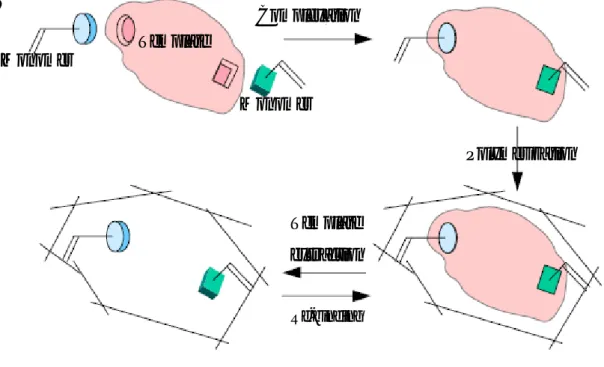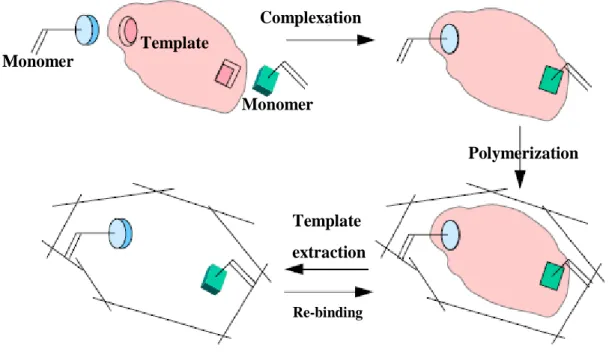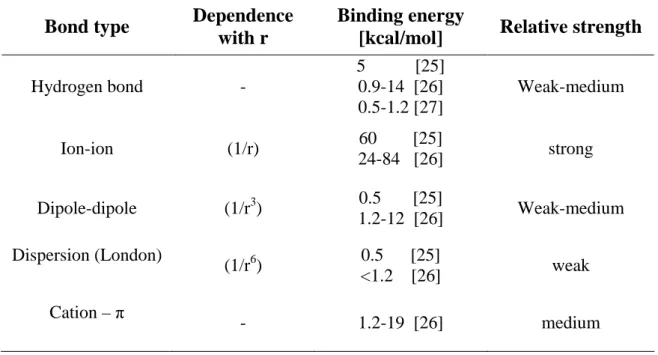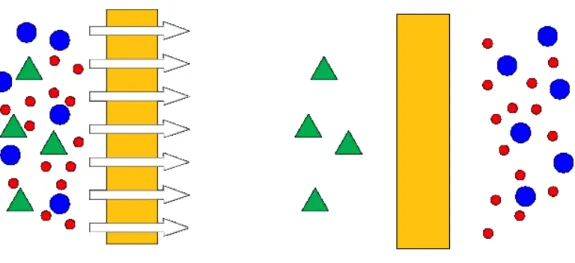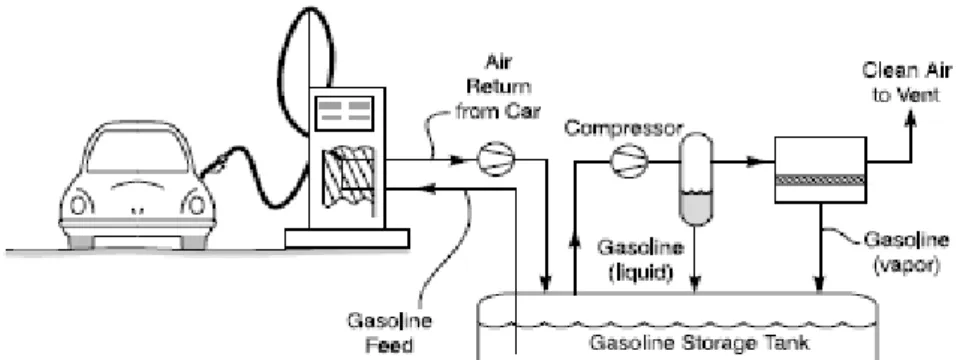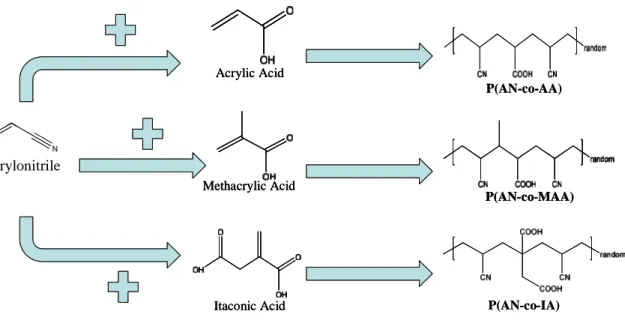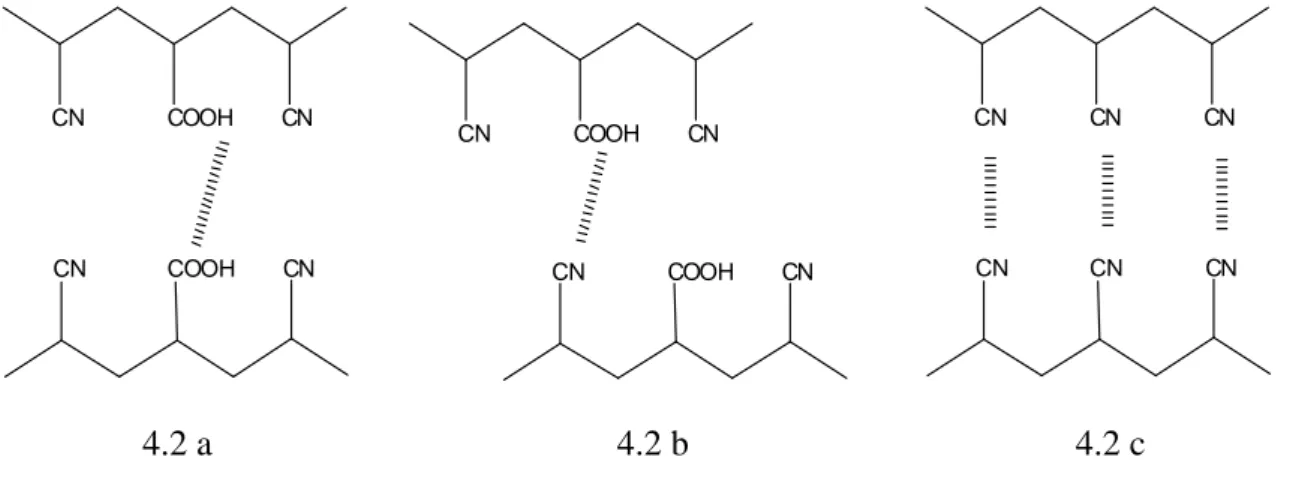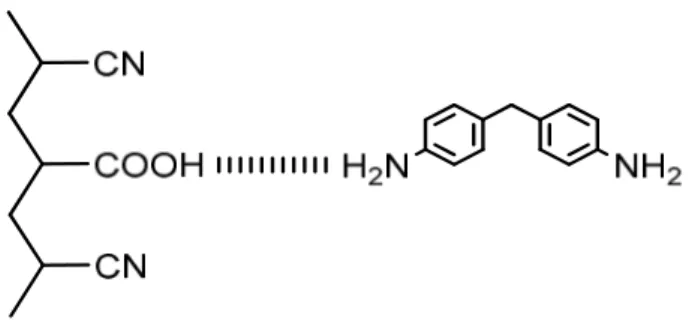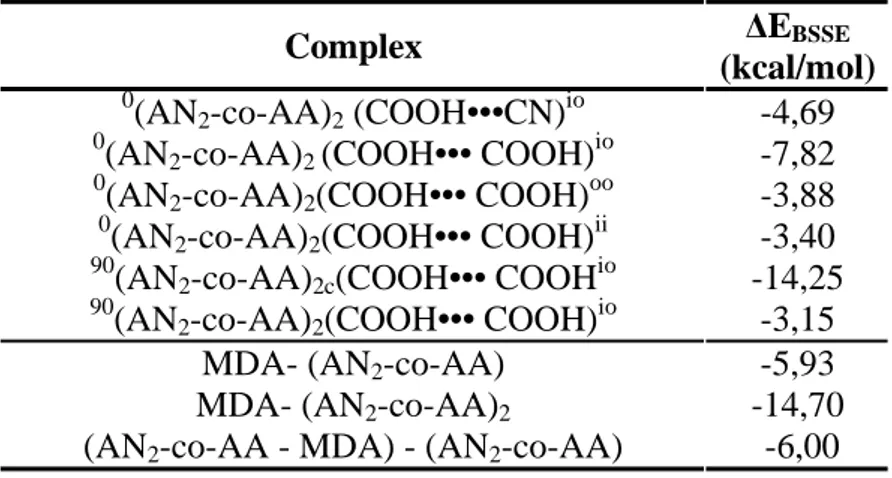A mis padres,
Sin vosotros este sueño nunca habría sido posible. Gracias por
todo. Os quiero.
“If I have seen further it is by standing on the shoulders of giants”.
INDEX
Preface
IPrefazione
IVReferences VII
Chapter 1: Theoretical Background
1.1 Introduction 2
1.2 The Schrödinger Equation and Hartree-Fock Theory 2
1.3 The Density Functional Theory 3
1.4 Noncovalent interactions. 7
1.4.1 Hydrogen bonding 10
1.4.2 Electrostatic Interactions (Dipolar interactions) 12
1.5.3 Dispersion Interactions 12
References 14
Chapter 2: Molecular Imprinting technique and membrane
Technology
2.1 Introduction to Molecular Imprinting Technique 172.2 Membrane Technology 17
2.2.1 Background 19
2.2.2 Recent trends concerning the membrane technology 21
2.2.2.1 Membranes for water treatment 21
2.2.2.2 Membranes for chemical/biomedical applications 27
2.2.2.3 Membranes for Gas Separation 32
2.2.2.4 Membranes for environmental applications 36
2.3 Molecularly Imprinted Membranes (MIMs): An overview 37
2.3.1 MIMs preparation strategies 37
2.3.1.1 From pre-synthesized MIPs to MIMs 38
2.3.1.2 Simultaneous formation of MIP and membrane structure: Cross- linking polymerisation 38
2.3.1.3 Simultaneous formation of MIP and membrane structure: Polymer solution phase inversion (PI) 38
2.3.1.4 Preparation of composite MIMs 4 0 2.3.2 MIMs Separations 41
2.3.2.1 Mechanisms for transport and selectivity 42
2.3.3 Performance of microporous MIMs 43
2.3.4 Macroporous MIM-MIP as affinity layer 43
2.3.4.1 MIP particles composited membranes 43
2.3.4.2 Thin layer MIP composited membranes 44
2.3.5 Performance of macroporous MIMs 44
2.3.6 Combinations of novel MIP formats with membrane separations 45
2.3.7 Final Remarks 45
References 48
Chapter 3: Materials and Methods
3.1 Membrane forming polymers 543.2 Target Molecules 55
3.3 Preparation and characterization of polymers 56
3.4 Preparation and characterization of flat-sheet membranes 57
References 61
Chapter 4: Results and Discussion
4.1 Computational Details 634.2 Evaluation of binding energies of the noncovalentinteractions 64
4.3 Causes controlling the affinity of the imprinted membranes for aminic compounds 71
4.4 Development of molecularly imprinted membranes for selective recognition of primary amines in organic medium 77
4.4.1 Preparation and characterization of polymers 71
4.4.2 Preparation and characterization of membranes 79
4.4.3 Binding tests 81
References 86
Conclusions and further works
88
Proceedings
92I
Preface
Molecular Imprinting is today a well known and established technique applied for the recognition of specific molecules by polymeric materials. The idea of copying the specificity in many natural systems, such as enzymes or antibodies, leaded to the firsts experimental uses and subsequent improvements of this technique. The molecular imprinting is based on the interaction and subsequent spatial orientation of polimerizable functional monomers around one template molecule [1]. The polymerization confers to the supra-molecular complex rigidity and stability creating the molecularly imprinted polymers (MIPs). A soft extraction of the template molecule leaves the cavities with the shape of the template into the polymeric network. As a result, these kinds of polymers show specific molecular recognition properties and they are largely able to re-bind selectively the template discriminating between other similar molecules. In figure P.1 it is provided a general representation of the molecular imprinting. Template Monomer Monomer Complexation Polymerization Template extraction Re-binding Template Monomer Monomer Complexation Polymerization Template extraction Re-binding
Figure P.1: Principle of the molecular imprinting technique.
Two main approaches of this technique were developed [2]: the covalent and non-covalent. In the covalent approach, the interaction between the template molecule and
II
the functional monomers occurs in a covalent manner, both in the polymerization step and in the subsequent recognition of the template. In spite of this approach gives a high selectivity, brings some disadvantages related with the limited number of monomers able to form covalent bonds with templates. Steric hindrance and an aggressive treatment for the extraction of templates are other common problems associated to this approach. As its own name indicates, the noncovalent interaction govern the assembly between template and functional monomers. The noncovalent approach is more widely used because offers a high variety of uses and the absence of a complicated synthetic chemistry in the preparation of polymers.
The combination between this technique and membrane technology leaded since the beginning of the 90s to the so-known as molecularly imprinted membranes (MIMs) [3]. The appearance in scene of MIMs was a cheap alternative to chromatographic methods because combine the mechanical stability of the membrane support and the specific recognition properties of MIPs materials. In spite of being a relatively young procedure, the (MIMs) technology is today one of the most applied tools in the membrane technology. However, more than 95% of the total publications about MIMs, are related with the utilisation of these in aqueous environments. This is due to the loss of the recognition efficiency of MIMs in organic solvents associated to the poor stability of the common MIMs forming materials.
In addition, there are not references in literature regarding theoretical studies, at molecular level, about the mechanism controlling the affinity of MIMs towards a particular template in organic media. Thus the scope of this PhD was the theoretical and experimental study of MIMs in organic environments.
During this PhD quantum-mechanics approach was used with the aim of acquire fundamental understanding about MIMs. Quantum mechanics calculations can help to estimate accurately some molecular chemical properties which are, currently, impossible to assess experimentally. Therefore, the theoretical knowledge acquired at the molecular level can predict and suggest novel polymeric materials to be used in the membrane technology. The work developed during this PhD can be divided in 2 areas: the experimental and theoretical part.
Concerning the experimental part, the main goal was to prepare and use molecularly imprinted membranes (MIMs) in flat-sheet configuration via the phase inversion technique using a noncovalent approach. The acquired experience of our institute on the use of MIMs in aqueous media [4-7], suggested us to extend their use in organic phase.
III
During the synthesis of most of pharmaceutical ingredients, usually, organic solvents remain polluted due to the uncompleted reaction of products utilized. The use of membranes as selective absorbers devices can help to remove some small toxic impurities such as primary aromatic amines. With the removal of these impurities, organic solvents remain cleaned and could be used again, saving energy and resources and preserving the environment.
As regards the theoretical part, the interpretation, at molecular level, of the experimental results was carried out in order to manage the experimental strategy to be used. Accurate quantum mechanics calculations were performed in the framework of Density Functional Theory (DFT). The theoretical interpretation allowed us to estimate some chemical-physical properties of the supramolecular complexes forming the MIMs, such as optimized structures and binding energies. The main goal was to understand the role of the noncovalent interactions in the impurity recognition showed by the MIMs. A comparative analysis of energies of the noncovalent interactions involved among polymeric chains and between polymeric chains with impurities was, therefore carried out. The knowledge obtained studying the noncovalent interactions can help to understand the mechanism controlling the “imprinting” phenomena in organic environments. Ad-hoc experiments were performed to verify the theoretical predictions. The thesis is divided in five chapters as follows:
In chapter 1, a short prologue about theoretical background of the aforementioned calculations is provided. Important information and classification of noncovalent interactions is also included here.
The chapter 2 contains a short introduction concerning the molecular imprinting technique, and an extensive background about the membrane technology including also MIMs.
The chapter 3 details carefully the preparation and characterization of the different membranes and the membranes forming polymers.
The chapter 4 includes a full discussion about the theoretical knowledge acquired as well as the different experimental results obtained. In addition, a section about computational details to explain the calculations used is also integrated.
IV
Prefazione
Lo stampo molecolare è oggi un tecnica ben nota ed affermata usata per il riconoscimento di molecole specifiche per mezzo di materiali polimerici. L´idea di imitare la specificità presente in molti sitemi naturali, come gli ezimi ed anticorpi, diede origine ai primi usi esperimentali e succesivi miglioramente di questa tecnica [1]. Lo stampo molecolare è basato nell´interazione e succesivo orientamento spaziale di diversi monomeri funzioni polimerizabili intorno ad una molecola stampo. Dopo la formazione del complesso, la polimerizzazione che avviene, conferissce al sistema una elevata rigidità ed stabilità creando i polimeri a stampo molecolare; in iglese molecularly imprinted polymers (MIPs). La estrazione della molecola stampo dalla rete polimerica lascia cavità che hano la sua forma especicifica. Di conseguenza, questo tipo di polimeri mostrano propietà specifiche di riconoscimento molecolare e sono, nella maggiore parte dei casi, in grado di discriminare tra la molecola stampo ed altre molecole chimica ed estrutturalmente analogue. In figura P.1 è fornita una rappresentazione generale dello stampo molecolare. Template Monomer Monomer Complexation Polymerization Template extraction Re-binding Template Monomer Monomer Complexation Polymerization Template extraction Re-binding
Figure P.1: Rappresentazione dello stampo molecolare.
Due approcci principali di questa tecnica sono stati sviluppati [2]: il covalente ed il noncovalente. Nell'approccio covalente, l'interazione tra la molecola ed i monomeri funzionali avviene in maniera covalente, sia nella fase di polimerizzazione che nella
V
succesivo riconoscimento della molecola stampo. Nonostante questo approccio offre una elevata selectività, porta con se alcuni svantaggi associati con il numero limitato di monomeri in grado di formare legami covalenti con gli stampi. L´ elelvato ingombro sterico ed un trattamento troppo agressivo per la rimozione della molecola stampo sono altri dei comuni problemi associati con questo approccio. Nell´aproccio non covalente, le interazione non covalenti, governano l´asemblaggio tra in monomeri e la molecola stampo. Questo approccio è molto più diffuso dovuto a che offre una elevata varietà di usi e la assenza di una complessa chimica sintetica per la preparazione dei polimeri. la combinazione dello stampo molecolare e la tecnologia a membrane diede origine dall´inizio degli anni 90 alle cosi dette membrane ad stampo molecolare; in inglese molecularly imprinted membranes (MIMs) [3]. Queste MIMs furono una reale ed economica alternativa ai metodi cromatografici esistenti in quel periodo in quanto consentivano una combinazione della stabilità meccanica del supporto di membrana con le propietà di riconoscimento dei MIPs. Nonostante sia una metodologia relativamente recente, essa è oggi una delle piu applicate nell´ambito della tecnologia a membrana. Tuttavia, più del 95% delle publicazione relative a le MIMs riguardano il suo utilizzo in ambienti aquosi.
Inoltre, non ci sono riferimenti in letteratura per quanto riguarda gli studi teorici, a livello molecolare, che trattano il meccanismo che controlla l'affinità delle MIMs verso una molecola in particolare in ambienti organici. Così lo scopo di questo dottorato è stato lo studio, a nivello teorico ed sperimentale delle MIMs in ambienti organici. Durante questo dottorato la meccanica quantistica è stata utilizzata con l'obiettivo di acquisire conoscenze basiche focalizzate sulle MIMs. I calcoli quantistici usati aiutarono as stimare con precisione alcune propietà fisico-chimiche che sono, attualmente, impossibili di valutare sperimentalente. Le conoscence teoriche acquisite a livello molecolare sono in grado di prevedere e suggerire nuovi materiali polimerici da utilizzare dopo nella tecnologia delle MIMs. Il lavoro svilupato nel corso di questo dottorato può essere diviso in due aree: la parte sperimentale e la parte teorica. per quanto riguarda alla parte sperimantale, l´obiettivo principale era la preparazione e caratterizzazione di membrane a stampo molecolare (MIMs) in configurazione di foglio piatto (flat-sheet) usando la tecnica di inversione si fase con l´approccio non covalente. La esperienza acquisita nel nostro istituto con questo tipo di membrane in mezzo aquoso [4-7] ci ha suggerito di estendere il loro utilizzo anche in ambienti organici. Durante la sintesi di la maggior parte dei ingredienti farmacologichi, di solito, i solventi organici
VI
rimangono inquinati a causa della reazione incompleta dei prodotti utizzati. L´utilizzo di MIMs come dispositivi assorbitori selectivi può aiutare a rimuovere queste impurità tossiche a volte, come per essempio, le amine aromatiche primarie (anilines). Con la rimozione di queste impurità i solventi rmangono puliti e potrebbero essere usati di nuovo, aiutando a rispariare energia e risorse, ed in definitiva, a preservare l´ambiente. Per quanto riguarda la parte teorica, l'interpretazione, a livello molecolare, dei risultati sperimentali è stata effettuata col fine di gestire la strategia sperimentale da utilizzare. Calcoli quantistica accurati sono stati effettuati nel ambito della teoria della Density Functional Theory (DFT). L'interpretazione teorica dei calcoli ci ha permesso di valutare alcune caratteristiche chimico-fisiche dei complessi supramolecolari che formano il MIM, come le strutture ottimizzate e energie di legame. L'obiettivo principale era quello di comprendere il ruolo delle interazioni non covalenti nel riconoscimento delle impurità mostrate dal MIM. Un'analisi comparativa delle energie delle interazioni non covalenti tra le catene polimeriche coinvolti e tra catene polimeriche con impurità è stata, quindi effettuata. Le conoscenze acquisite studiando le interazioni non covalenti possono aiutare a capire il meccanismo di controllo dell´ "imprinting" fenomeno in ambienti organici. Esperimenti Ad-hoc sono stati eseguiti per verificare le previsioni teoriche. La tesis è divisa in 4 capitoli come segue:
Nel capitolo 1 è fornito un breve background riguardante ai calcoli quantistici previamente citati. Importanti informazioni sulle interazioni noncovalenti sono anche state incuse qui.
Il capitolo 2 contiene una breve introduzione sulla tecnica dello stampo molecolare, un ampio background su la tecnologia a membrana e finalemente una parte dedicata esclusivamente alla tecnologia delle MIMs.
Il capitolo 3 describe in dettaglio la preparazione e caratterizzazione delle membrane usate e dei diversi polimeri che formano le membrane.
Il capitolo 4 include un completa discussione sulle conoscenze teoriche acquisite ed inoltre i diversi risultati esperimentale ottenuti. Peraltro, una sezione sui dettagli computazionali per spiegare i calcoli uttilizzati è pure integrata qui.
Dopo sono incluse le conclusioni finale e lavori futuri per svilupare. Alla fine sono state aggiunte le pubblicazioni scientifiche,ed i proceedings in conferenze internazionali.
VII
References
[1] Yoshikawa, M., Biosep. (2002) 10, 277.
[2] Mayes, A.G., Whitcombe, M.J., Adv. Drug. Deliv. Rev. (2005) 57, 1742.
[3] Wang, X.J., Xu, Z.L., Bing, N.C., Yang, Z.G., J. Appl. Pol. Sci. (2008) 109, 64. [4] Donato, L., Figoli, A., Drioli, E., J. Pharm. Biomed. An. (2005) 37, 1003. [5] Tasselli, F., Donato, L., Drioli, E., J. Membr. Sci. (2008) 320, 167. [6] Donato, L., Tasselli, F., Drioli, E., Sep. Sci. Tech. (2010) 45, 2273. [7] Donato, L., Greco, M.C., Drioli, E., Desal. Wat. Treat. (2011) 30, 1.
1
C
C
h
h
a
a
p
p
t
t
e
e
r
r
1
1
T
T
h
h
e
e
o
o
r
r
e
e
t
t
i
i
c
c
a
a
l
l
B
B
a
a
c
c
k
k
g
g
r
r
o
o
u
u
n
n
d
d
2
1.1 Introduction
The computational chemistry can provide a great deal of insight into a large variety of chemical systems. In fact, the computational chemistry permits to investigate properties of systems that are often inaccessible using experimental techniques. Ascomputers with new algorithms become faster and more powerful, an increasing number of scientists are supplementing their research with computational results [1]. Computational chemistry has been widely applied in the pharmaceutical industry, as well as in the design of new materials, and it has been particularly successful in both areas. This approach can save synthetic efforts, reducing not only the material amount used but also precious manpower. As the world moves into an era of greater environmental consciousness, the optimization of resources it is being more and more a wished objective. On the other hand, computational chemistry is often used to complement experimental work, providing the detailed information needed to support experimental hypotheses [2]. In this chapter, the basic concepts of the quantum theory (Density Function Theory), used to carry out the evaluation of some molecular key properties are illustrated. In particular, the purpose of the chapter is to provide the reader with a fundamental understanding of the Density Function Theory employed during the thesis, while thorough discussions can be found in various theoretical chemistry textbooks [3-7].
One of the fundamental aspects in the study of the interface properties are the binding energies associated with noncovalent interactions involved between the functional groups constituting the interface and the permeating molecules. Thus, the last section of this chapter will explain this kind of interactions. Computational chemistry supported by the modern quantum chemistry is a very important tool useful for the evaluation of these properties.
1.2 The Schrödinger Equation and Hartree-Fock Theory
In the early 20th, to accurately describe and predict the properties of atoms and molecules a new set of laws, different of classical mechanics, was needed and thus the quantum mechanics was born. These new laws accounted for the wave-particle duality of electrons, a feat that classical mechanics had failed to overcome. The laws of
3
quantum mechanics are extremely elegant: any microscopic system can be described by a function, known as the wave function (Ψ). It contains all the information about the system. Very briefly, the final goal of the quantum mechanics is the determination of the correct wave function for a specific system. Unfortunately, due to the complex nature of wave function for many electrons quantum systems, an exact solution at the time it is impossible. In order to overcome this drawback several approximations and assumptions were made. Ultimately, each method discussed in this chapter employs a specific set of assumptions and as a consequence each has its own advantages and disadvantages. In quantum mechanics each observable, that is a chemical-physical property, can be described by on Hermitian operator. A representation of this operator is obtained using an appropriate set of basis in the Hilbert space, which are particle states. All the observables, that is operators, and auto functions of these operators can be represented using a particular set of basis (complete set). The value of a chemical-physical property of a quantum system is obtained by the scalar product:
A A
' (1.1)
in which A is the state of the quantum system (not an eigenstate of ) and is the
Hermitian operator, while ' is the mean value of the chemical-physical property
considered. Using an infinite basis set, that is the eigenstates of the position of a single particle, the average value of the observable Ɵ when the microscopic system is in the state A can be writen as:
i Axi xi xi xi A ' (1.2)The operator associated to the total energy of the microscopic system is called Hamiltonian.
The Schrodinger equation is the eigenvalue equation defining the mean values of the Hamiltonian operator in a representation in which the auto functions are the auto states of the electron position operator. This basis equation, enunciated in 1926, is the basis of the modern quantum mechanics:
x
x4
where H is the Hamiltonian operator and E is the energy of the system. The solutions to the equation 1.3 are the stationary auto states of the energy of the system under investigation. The solution with the lowest energy, E0, represents the ground state. One of the fundamental assumptions made in quantum chemistry is that of Born and Oppenheimer. It assumes that since the nuclei are so much more massive and slow than the electrons they can be considered stationary while the electrons move quickly in the field of fixed nuclei. Thus, the nuclear and electronic motions are separable. This assumption has the effect of simplifying the Hamiltonian of the electronic system since the kinetic energy of the nuclei tends to be zero and the inter-nuclear repulsion term becomes a constant. The total electronic Hamiltonian can then be separated into an electronic and a nuclear component. Then, in the Born and Oppenheimer approximation, the problem is to obtain the electronic structure of an ensemble of fixed nucleus. The computational effort for the exact solution of this problem scales exponentially with respect to the number of electrons of the system. As consequence, several approximations have been developed, the simplest being the Hartree–Fock (HF) theory. According to the HF theory, in each quantum system, electron moves in a mean field generated by the other electrons and nuclei of the system. In this case, the many-electron Schrödinger equation is reduced to a mono many-electron problem in which each electron of the many-body system experiments the electrostatic field of nuclei and the average fields of the electrons. The HF method provides the basis for many other accurate methods.
In particular, the HF solution is the auto functions and eigenvalues that are the orbitals and their energies of the electrons forming molecules and atoms, respectively. From electronic orbitals, it is possible to obtain the electron density and the average value of each observable of the quantum system, thus also the total energy. The total energy carried out by the HF method must be considered as an approximation of the real energy of the quantum system in its ground state, E0. The variational principle says that an approximation of the energy of a quantum system obtained from a Hamiltonian is always higher than that of the real ground state.
0 E
Eapprox (1.4) The difference between E0HF and E0 is defined as the correlation energy. Therefore, while the exchange energy between 2 electrons due to the exclusion principle of Pauli is
5
evaluated in the HF theory, the energy due to the interaction of contrary spin is not taken into account in this approximation.
There are several ways to evaluate the aforementioned correlation energy. The most common methods are configuration interaction (CI) and coupled cluster (CC). Both of them provide a systematic way to converge towards the exact solution. Another useful approximation is the theory of perturbations as implemented by C.Møller and M.S. Plesset (MPPT).
The Density Functional Theory assumes that the information on the system can be obtained from the electron density and thus it does not actually solve the Schrodinger equation. The DFT is not just a smart way to evaluate the correlation energy; it can be considered a new approach to the quantum mechanics.
1.3 Density Functional Theory
The foundation of modern DFT rests on two theorems by Hohenberg and Kohn. The first one establishes a one-to-one correspondence between the exact many-body ground-state wave function and the corresponding electron density,
r . It states: the external potential
r is determined, within a trivial additive constant, by the electron density
r of the considered quantum system.Since
r determines the number of electrons, it follows that
r also determines the ground-state wave function Ψ and all other electronic properties of the system. Thus, also the energy of the ground-state. This energy is, therefore a function of the electronic density and as a consequence of the external potential. For each external potential only correspond one electronic density:
r r dr FHK
E
(1.5) where
ee
HK T V F (1.6)where which T
is the kinetic energy and Vee
is the electron-electron interaction energy. The classical part of Vee
is the Coulomb potential energy. To produce the6
of electrons of the considered interacting system, the FHK functional (1.6) can be rewrite as:
s
xc
HK T J E F (1.7) with
T
T
V
J
Exc s ee (1.8)Being Ts
the non-interacting kinetic energy, J
the Coulomb potential energy. The defined quantity Exc
is called the “exchange-correlation energy”. It contains thedifference between T and Ts kinetic energy and the non-classical part of Vee
. Therefore, the exchange correlation energy” can be estimated using this functional, unlike above HF Theory.The second theorem provides the energy variational principle. It reads: for a trial density ),
r (
such that (r)0and
(r)dr N, where N is the number of electrons of the system, the energy of the ground state is always smaller than energy obtained by the functional in which v is the aforementioned external potential:
E
E 0 (1.9) Assuming the differentiability of E
, the variational principle requires that the ground state density satisfies the stationary principle:
E
r drN
0 (1.10)
which gives the Euler-Lagrange equation
r F r r E (1.11)7
A useful procedure to obtain the (r ) of the ground state energy was made by Kohn and Sham. They did not resolve directly the above Euler-Lagrange equation. They defined the (r ) as function of molecular or atomic orbitals, as follows:
n i 2 i r r (1.12)Then, the total functionals (1.5) and (1.7) can be rewritten as function of these orbitals with the constrain of the orbitals orthonormality. The functional of the total energy written as function of i
r has to satisfy the stationary principle (1.10):
0 i (1.13)
Finally, the orbitals, defining the electron density solution (1.12), are given by the Kohn and Sham equations:
i i i eff i 2 i v 2 1 (1.14) where
r E r J r v r veff xc i =
dr v r ´ r r ´ r r v xc (1.15) i are Lagrange multipliers for the orbitals orthonormality constraints. Exploiting the
definition of the total energy functional given in the equation (1.7), the values can be i
associated to the eingvalues of the one eletronic orbitals that is the energies of these i
orbitals.
1.4 Non covalent interactions
Atoms and molecules can interact together leading to the formation of either a new molecule (reactive channel) or a molecular cluster (nonreactive channel), respectively. In the former case, covalent interactions are clearly involved; in the latter, in which a
8
covalent bond is neither formed or broken, noncovalent or van der Waals (vdW) interactions are implicated. This nomenclature is, however, not well-defined and the term vdW interactions is sometimes used only for certain noncovalent interactions (mostly dispersion, see later). The noncovalent interactions were first recognized by J. D. van der Waals[8] in the last century and helped him to reformulate the equation of state for real gases. Noncovalent interactions are considerably weaker than covalent interactions. The role of noncovalent interactions in nature was fully recognized only in the last two decades; they play an important role in chemistry and physics. They are of key importance in the bio-disciplines. The structures of liquids, solvation phenomena, molecular crystals, physisorption, structures of macromolecules such as DNA and proteins, and molecular recognition are only a few examples in which noncovalent bonds are fundamental. The noncovalent interactions define the supramolecular chemistry area [9]. Non covalently assisted synthetic procedures are used to assemble various types of supramolecular species. Supramolecular chemistry offers incredible applications in various fields such as medicinal chemistry (drug delivery systems) [10-13], host-guest chemistry [14], catalysis [15-17], and molecular electronics [18]. Covalent and noncovalent interactions differ considerably and have completely different origins. A covalent bond is formed when partially occupied orbitals of interacting atoms overlap and consists of a pair of electrons shared by these atoms. Noncovalent interactions are known to act at distances of several angstroms and the overlap is thus unnecessary; in fact the overlap between occupied orbitals leads only to repulsion. The reason for the attraction between interacting subsystems must be sought elsewhere and it can lie only in the electrical properties of the subsystems. Noncovalent interactions originate from interaction between permanent multipoles, permanent multipole and induced multipole, instantaneous multipole and induced multipole and finally between instantaneous multipoles. The respective energy terms, called electrostatic, induction, and dispersion are basically attractive. However, the electrostatic term, depending on the orientation of the subsystems, can be attractive or repulsive. The repulsive term, due to the electron-electron repulsion and connected with the above mentioned overlap of occupied orbitals, prevents the subsystems approaching too closely. It is useful to consider how covalent and noncovalent interactions differ. First, there is the difference in stabilization energy and equilibrium distance: noncovalent clusters have a characteristic stabilization energy of few kilocalories per mole with intermolecular distances of about or larger than 2 Å, while covalently bound molecules have typical
9
binding energies of about 100 kcal/mol with typical interatomic distances below 1.5 Å. It is important to remark that the ionic bonds even being noncovalent bonds show a high binding energy as shown in Table 1.1. Entropy, always, plays a dominant role in noncovalent interactions. In fact, in the covalent interactions, the enthalpy is larger than the entropy term, and therefore, the respective change of free energy is determined mainly by the enthalpy energy term. On the contrary, in the case of the noncovalent bonds, the enthalpy terms are smaller than values related to the covalent ones therefore the entropy can assume a relevant importance. An important difference concerns the potential energy surface (PES), which is much richer of minima and maxima for noncovalent clusters. The number of energy minima of larger clusters is bigger, and to find these on a PES requires effective search method. On the basis of perturbation theory, the total stabilization energy of noncovalent complexes can be partitioned into various energy contributions. As mentioned above, the electrostatic, induction, dispersion terms and charge-transfer, form the dominant attractive contributions. The relative importance of these energy terms differ for specific types of noncovalent clusters. In some cases, one particular energy term is dominant. Typically, various attractive terms contribute to the overall stabilization of noncovalent clusters: the complexes showing hydrogen bonds provide a typical example. To describe and study noncovalent interactions, it is essential to apply the most accurate methods of quantum chemistry.
Synthetically, the types of noncovalent interactions can be summarised as follows: hydrogen bonds (H-bonds), electrostatic interactions which include both the ion-ion and also the dispersion forces, and the charge-transfer interactions. In table 1.1, these noncovalent interactions are summarized with the relative strength.
10
Table 1.1: Classification of noncovalent interactions
The hydrogen bond, electrostatic and dispersion interaction will be described below because among the reported noncovalent interactions, they are supposed to be the driving forces of the increased affinity towards aminic compounds showed by the imprinted membranes described in chapter 3 of this thesis.
1.4.1 Hydrogen Bonding
H-bonded complexes are by far the most important and numerous noncovalent complexes [19]. The formation of a X-H…Y H-bond is accompanied by an elongation of the X-H bond which causes a decrease (red-shift) of the respective X-H stretching frequency. The red-shift is easily observable and provides unambiguous evidence about the formation of a noncovalent H-bonded complex. In general, the H-bonds have electronegative atoms as X, with Y either an electronegative atom having one or two lone pairs or a group with a region of excess of electron density (e.g., π-electrons of aromatic systems). In Table 1 the classification and some properties of the hydrogen bonds are reported.
Bond type Dependence with r
Binding energy
[kcal/mol] Relative strength
Hydrogen bond - 5 [25] 0.9-14 [26] 0.5-1.2 [27] Weak-medium Ion-ion (1/r) 60 [25] 24-84 [26] strong Dipole-dipole (1/r3) 0.5 [25] 1.2-12 [26] Weak-medium Dispersion (London) (1/r6) 0.5 [25] <1.2 [26] weak Cation – π - 1.2-19 [26] medium
11
Table 1.2: Classification and some properties of hydrogen bonds.
Strong Moderate Weak
D-H···A interaction
Mainly covalent Mainly electrostatic Electrostatic
Binding energy
( kcal/mol -1) 14–29 3.9–14 < 2.9
Bond lengths (Å): H···A 1.2–1.5 1.5–2.2 2.2–3.2
Bond angle ( degree ) 175–180 130–180 90–150
Examples
Gas phase dimers with strong acids/bases, HF complexes Acids, Biological molecules C-H···N/O and N/O–H···π hydrogen bond
What is the driving force for geometrical and spectral evidences of H-bonding? By natural bond orbital analysis it was shown [20] that it is the charge transfer (CT) from the lone pair or ð-molecular orbitals of the electron donor (proton acceptor) to the orbitals of the X-H bond of the electron acceptor (proton donor). An increase of the electron density in X-H orbitals causes elongation of the X-H bonds, which causes the red-shift of the X-H stretching frequency. This is accompanied by a very small CT that usually does not exceed more than 0.01 a.u. The CT is, however, considerably more important for ionic clusters. Depending of the orbitals overlapping of donator and acceptor involved in the hydrongen bond, the distance between hydrogen and acceptor varies. I that distance is between 1.2 and 1.5 Å the formed bond is mainly covalent, if is between 1.5 and 2.2 Å is mainly electrostatic and finally longer distances produce electrostatic interactions. Both C-H…Y as well as C-H…π types of H-bonds have been
observed [21,22]. If the hydrogen atom of a CH group is acidic, it can form quite strong H-bonds, otherwise, the C-H…Y hydrogen bonds are much weaker than OH…Y or NH…Y H-bonds. Nevertheless, C-H…Y H-bonds could play an important role in bio-molecular structures due to their large number. The other two types of interbio-molecular bonds with participation of hydrogen, namely the improper (blue- shifting) H-bond and the dihydrogen bond, were described only recently, and they are less numerous than H-bonds. The C-H…π improper (blue-shifting) H-bond was theoretically predicted in
carbon proton donor…benzene complexes [23]. The manifestation of this bond is completely opposite to that of a normal H-bond, i.e., instead of an elongation of the X-H
12
bond and a red-shift of the X-H stretch vibrational frequency upon complex formation, there is a contraction of the bond length and a blue-shift of the stretch frequency. The dihydrogen bond such as M-H…H-Y was originally found [24] in metal complexes (M = metal element) and later detected in the H3BNH3 dimer. The explanation of this unconventional H-bond is straightforward: two hydrogens may interact weakly if one is bound to an electropositive element and the other to a very electronegative element. Consequently, one hydrogen has positive and the other has negative charge and there is a multipole attraction between these hydrogens.
1.4.2 Electrostatic Interactions (Dipolar Interactions)
There are various types of electrostatic interactions. The ion-dipole, ion-induced dipole, dipole-dipole, induced dipole-dipole should be taken into account. They are much weaker than ionic or covalent bonds and have a significant effect only when the molecules involved are close together (touching or almost touching).
Ion-dipole interactions are attractive force that results from the electrostatic attraction between an ion and a neutral molecule that has a dipole. They are most commonly found in solutions, especially in solutions of ionic compounds in polar liquids. A positive ion (cation) attracts the partially negative end of a neutral polar molecule or a negative ion (anion) attracts the partially positive end of a neutral polar molecule. Dipole-dipole interactions are attractive forces. They are formed between the positive end of the dipole of one molecule and the negative pole of the dipole of another molecule. Polar molecules have local density of charge positive and negative due to the differences in electronegativity of their constituent atoms. Dipole-dipole forces have strengths that range from 1.2 kJ to 5 kccal/mol and they depend on r3 where r isthe dipole distance, as shown in Table 1.2. Dipole-induced dipole forces result when an ion or a dipole induces a dipole on an another molecule with no dipole. An ion-induced dipole attraction is a weak attraction that results when the approach of an ion or dipolar molecule induces a dipole in a nonpolar molecule by disturbing the arrangement of electrons in the nonpolar species.
1.4.3 Dispersion Interactions
Dispersion interactions are less directionally specific than previous electrostatic interactions. They are determined by the instantaneous fluctuation of the electrons
13
Induced dipole- induced dipole. Thus, also polar molecules can also have this kind of interactions. Dispersion interactions are also called London interactions. This is, for example, the case for stacked DNA base pairs (π-staking). Dispersion energy plays an important role in stabilizing clusters of bio-macromolecules, where it may be the dominant attractive term. Dispersion energy is of vital importance in stacking interactions in bio-macromolecules and may be more important than stabilization by charge-transfer. In an imprecise way, the dispersion interactions are also known as hydrophobic interactions. Hydrophobic interactions represent the tendency of non-polar groups (especially hydrocarbon groups) to associate among them in aqueous solutions. This association is accompanied by little change of enthalpy and thus the process of association of non-polar groups is governed by entropy effects, because any association of systems is always connected with a negative entropy change.
14
References.
[1] Jensen, F., Introduction to Computational Chemistry (Second Edition) , John Willey & Sons Ltd (2007).
[2] Clark, T., A Handbook of Computational Chemistry, Wiley, (1985). [3] Levine, I. N., Quantum Chemistry. Fifth ed.; Prentice Hall, Inc, (2000).
[4] Szabo, A., Ostlund, N. S., Modern Quantum Chemistry: Introduction to Advanced
Electronic Structure Theory. McGraw-Hill, Inc, (1989).
[5] Koch, W., Holthausen, M.C., A Chemist's Guide to Density Functional Theory. Second ed.; Wiley-VCH, (2001).
[6] Bader, R. F. W., Atoms in Molecules: A Quantum Theory. Oxford University Press, (1990).
[7] Popelier, P., Atoms in Molecules: An Introduction. Pearson Education Limited, (2000).
[8] Van der Waals, J. D., Doctoral Dissertation, Leiden, (1873).
[9] Lehn, J.M., Atwood, J. L., Davies, J. E. D., MacNicol, D. D., Vögtle, F.,
Comprehensive Supramolecular Chemistry Eds.; Pergamon: Oxford, (1996).
[10] Duncan, R.; Kopecek, J., Adv. Polym. Sci. (1984), 57, 51.
[11] Peppas, N. A.; Nagai, T., Miyajima, M., Pharm. Technol. Jpn. (1994) 10, 611. [12] Bieniarz, C., Technology Encyclopedia of Pharmaceutical; Marcel Dekker: New York, (1999), p 55.
[13] Akiyoshi, K., Kagagu (Kyoto) (1994) 49, 442. [14] Tzalis, D.; Tor, Y. Tetrahedron Lett. (1996) 37, 8293.
[15] Huck, W. T. S.; Prins, L. J.; Fokkens, R. H.; Nibbering, N. M.; van Veggel, F. C. J. M.; Reinhoudt, D. N., J. Am. Chem. Soc. (1998) 120, 6240.
[16] Knapen, J. W. J., van der Made, A. W., de Wilde, J. C., van Leeuwen, P. W. W. N. M.; Wijkens, P., Grove, D. M.; van Koten, G., Nature (1994) 372, 659.
[17] Kokufuta, E., Adv. Polym. Sci. (1993) 110, 157.
[18] Warshel, A., Papazyan, A., Kollman, P. A., Science (1995) 269, 102.
[19] Scheiner, S., Hydrogen Bonding. A Theoretical Perspective; Oxford University Press: New York, (1997).
[20] Starikov, E. B., Steiner, T., Acta Crystallogr., Sect. D (1997) 53, 345. [21] Steiner, T., Desiraju, G. R., Chem. Commun. (1998), 891.
15
[22] Djafari, S., Barth, H.D., Buchold, K., Brutschy, B., J. Chem. Phys. (1997) 107, 10573.
[23] Reed, A., Curtiss, L. A., Weinhold, F., Chem. Rev. (1988) 88, 899.
[24] Lee, J. C., Peris, E., Rheingold, A. L., Crabtree, R. H., J. Am. Chem. Soc. (1994)
116, 11014.
[25] Atkins, P. W., Physical chemistry.VCH: Weinheim, (1996).
[26] Steed, J. W., Atwood, J. L., Supramolecular chemistry; John Wiley & Sons(2000). [27] Perrin, C. L., Nielson, J. B., Annu. Rev. Phys. Chem. (1997) 48, 511.
16
C
C
h
h
a
a
p
p
t
t
e
e
r
r
2
2
M
M
o
o
l
l
e
e
c
c
u
u
l
l
a
a
r
r
i
i
m
m
p
p
r
r
i
i
n
n
t
t
i
i
n
n
g
g
T
T
e
e
c
c
h
h
n
n
i
i
q
q
u
u
e
e
a
a
n
n
d
d
M
M
e
e
m
m
b
b
r
r
a
a
n
n
e
e
T
T
e
e
c
c
h
h
n
n
o
o
l
l
o
o
g
g
y
y
17
2.1 The Molecular Imprinting Technique
During the last decades the utilization of molecularly imprinted polymers (MIPs) in many research areas has been extensively developed. The result of this development, has been a spectacular and progressive increasing of the related works published per year. Two main approaches for molecular imprinting were proposed. In the procedure firstly proposed by Wulff [1] and called covalent molecular imprinting, the complex functional monomer-template interacts by a covalent bond and is later polymerized. The second approach was proposed by Moshbach [2] and named non-covalent imprinting. In this way a cross-linked polymer interacted with the template molecule simply through electrostatic interaction, hydrogen bonding or similar non-covalent bonds. Recently, the semi-covalent approach has been also described [3-4]. This method combines both procedures previously described. Utilization of molecular imprinting technique has been widely reported for the preparation of molecularly imprinted polymers (MIPs). Actually, MIPs technology is strong and robust tool widely studied and developed. It has a large established market and is extensively utilised in a great variety of different applications. For instance, MIPs have been used as sensors for detection of various compounds,[5,6] in recognition studies [7,8], chiral separations [9,10], mimicking of binding sites of antibodies, receptors,[11] and enzyme catalysis [12]. Membrane technology had started to be used and developed a long time before the born of imprinting technique and was a consolidated and potent tool in the ambit of molecular separations. The challenge of involve MIPs in the membrane preparation process suddenly attracted the attention of numerous scientists because opened a new innovative way in molecular separations and represented a strong and cheap alternative to chromatographic methods. The first work involving molecularly imprinted membranes (MIMs) was proposed, as mentioned in the preface, at the beginning of the 90s. An exhaustive discussion about membrane technology including MIMs technology is exposed bellow.
2.2 Membrane Technology
A membrane is an inter phase between two adjacent phases acting as a selective barrier, regulating the transport of substances between the two compartments[13]. The main advantages of membrane technology as compared with other unit operations in chemical engineering are related to the transport selectivity of the membrane. Separations processes with membranes do not require additives, and they can be performed
18
isothermally at low temperatures and compared with other thermal separation processes- at low energy consumption. Membranes have gained an important place in chemical technology and are used in a broad range of applications[13,14]. The key property that is exploited is the ability of a membrane to control the permeation rate of a chemical specie through the membrane.
In controlled drug delivery, the goal is to moderate the permeation rate of a drug from a reservoir to the body. In separation applications, the goal is to allow one component of a mixture to permeate the membrane freely, while hindering permeation of other components.
Figure 2.1: Illustration of a membrane used in molecular separations.
The major examples are water purification by reverse osmosis and blood detoxification by dialysis or ultrafiltration. Membranes have also big importance in the food and pharmaceutical industry as well as the process and waste water treatment. Other important applications have been realized in gas separation. Today synthetic separation membrane processes can be classified according different criteria:
*Membrane materials: Organic polymers, inorganic materials (oxides, ceramics, metals…) organic-inorganic composited materials.
*Preparation Method: Phase inversion of polymer solution, sol-gel process towards inorganic or organic-inorganic materials, interface reaction towards thin-layer composite, stretching, extrusion, track-etching, micro-fabrication.
19
During this PhD I worked with flat-sheet and composite MIMs (Molecular Imprinted Membranes) synthetic membranes made of organic polymers and prepared by Phase inversion Technique for the removal of some impurities in non aqueous systems.
2.2.1 Background
Systematic studies of membrane phenomena can be traced to the eighteenth century philosopher scientists. For example, Abbe Nolet coined the word ‘osmosis’ to describe permeation of water through a diaphragm in 1748. Through the nineteenth and early twentieth centuries, membranes had no industrial or commercial uses, but were used as laboratory tools to develop physical/chemical theories. For example, the measurements of solution osmotic pressure made with membranes by Traube and Pfeffer were used by Vant Hoff in 1887 to develop his limit law, which explains the behaviour of ideal dilute solutions; this work led directly to the Vant Hoff equation. At about the same time, the concept of a perfectly selective semi permeable membrane was used by Maxwell and others in developing the kinetic theory of gases. In 1907, Bechhold devised a technique to prepare nitrocellulose membranes of graded pore size, which he determined by a bubble test [15]. Other early workers, particularly Elford [16], Zsigmondy and Bachmann [17] and Ferry [18] improved on Bechhold’s technique, and by the early 1930s, microporous colloidal membranes were commercially available. During the next 20 years, this early microfiltration membrane technology was expanded to other polymers, notably cellulose acetate. Membranes found their first significant application in the testing of drinking water at the end of World War II. Drinking water supplies serving large communities in Germany and elsewhere in Europe had broken down, and filters to test for water safety were needed urgently. The research effort to develop these filters, sponsored by the US Army, was later exploited by the Millipore Corporation, the first and still the largest US microfiltration membrane producer.
By 1960, the elements of modern membrane science had been developed, but membranes were used in only a few laboratory and small, specialized industrial applications.Membranes suffered from four problems that prohibited their widespread use as a separation process: They were too unreliable, too slow, too unselective, and too expensive. Solutions to each of these problems have been developed during the last 50 years, and membrane-based separation processes are now commonplace.
20
The seminal discovery that transformed membrane separation from a laboratory to an industrial process was the development, in the early 1960s, of the Loeb–Sourirajan process for making defect-free, high-flux, anisotropic reverse osmosis membranes [19]. These membranes consist of an ultrathin, selective surface film on a much thicker but much more permeable microporous support, which provides the mechanical strength. The flux of the first Loeb–Sourirajan reverse osmosis membrane was 10 times higher than that of any membrane then available and made reverse osmosis a potentially practical method of desalting water. The work of Loeb and Sourirajan, and the timely infusion of large sums of research and development dollars from the US Department of Interior, Office of Saline Water (OSW), resulted in the commercialization of reverse osmosis and was a major factor in the development of ultrafiltration and microfiltration. The development of electrodialysis was also aided by OSW funding.
Concurrently with the development of these industrial applications of membranes was the independent development of membranes for medical separation processes, in particular, the artificial kidney. W.J. Kolf had demonstrated the first successful artificial kidney in The Netherlands in 1945. It took almost 20 years to refine the technology for use on a large scale, but these developments were complete by the early 1960s. Since then, the use of membranes in artificial organs has become a major life-saving procedure. Various million people around the world are now sustained by artificial kidneys and a further million people undergo open-heart surgery each year, a procedure made possible by development of the membrane blood oxygenator. The sales of these devices comfortably exceed the total industrial membrane separation market. Another important medical application of membranes is for controlled drug delivery systems. A key figure in this area was Alex Zaffaroni, who founded Alza, a company dedicated to developing these products in 1966. The membrane techniques developed by Alza and its competitors are today widely used in the pharmaceutical industry to improve the efficiency and safety of drug delivery.
The period from 1960 to 1980 produced a significant change in the status of membrane technology. Building on the original Loeb–Sourirajan technique, other membrane formation processes, including interfacial polymerization and multilayer composite casting and coating, were developed for making high performance membranes. Using these processes, membranes with selective layers as thin as 0.1 μm or less are now being produced by a number of companies. Methods of packaging membranes into large-membrane-area spiral-wound, hollow-fine-fiber, capillary, and plate-and-frame
21
modules were also developed, and advances were made in improving membrane stability. By 1980, microfiltration, ultrafiltration, reverse osmosis and electrodialysis were all established processes with large plants installed worldwide.
The principal development in the 1980s was the emergence of industrial membrane gas separation processes. The first major development was the Monsanto Prism membrane for hydrogen separation, introduced in 1980. Within a few years, Dow was producing systems to separate nitrogen from air, and Cynara and Separex were producing systems to separate carbon dioxide from natural gas. The final development of the 1980s was the introduction by GFT, a small German engineering company, of the first commercial pervaporation systems for dehydration of alcohol. Membrane gas separation technology has been extensively investigated and developed in the last 3 decades. In one world already conscious with global warming and with the necessity to preserve the natural resources, the main object of study has been the carbon dioxide separation and capture. During the decade of 1990s appeared the so-know as molecularly imprinted membranes. There is a section in this chapter exclusively dedicated to this particular kind of membranes.
2.2.2 Recent trends concerning the membrane technology
Today membrane technology is widely studied, applied and developed. Membranes and membranes based devices are present in our daily life and they make it easier. I will explain briefly the breakthroughs and recent novelties produced during the last years concerning the most important areas of membrane technology.
Nowadays, the hottest highlights in membrane technology concern about water treatment, chemical/biomedical applications, gas separations, and environmental applications. It is important to emphasize that membrane technology has an enormous number of other applications that will not be mentioned here. This is just a small resume of the applications about 4 big important and essential areas inside the wonderful world of membranes.
2.2.2.1 Membranes for water treatment
The main goal regarding the water treatment is the production of ultra pure water from different sources. Because of vastly expanding populations, increasing water demand, and the deterioration of water resource quality and quantity, water is going to be the
22
most precious resource in the world. Thus, the 21st century is called the “water century.” In the 20th century, membrane technologies made great progress, and commercial markets have been spreading very rapidly and throughout the world. Since largest source of water is the sea numerous works have been addressed to obtain ultra pure water from sea water by the process known as seawater desalination. Seawater desalination is the production of fresh, low-salinity potable or industrial-quality water from a saline water source (sea, bay, or ocean water) via membrane separation or evaporation. Today, seawater desalination is mostly used to produce fresh potable water for human consumption and crop irrigation. Industrial applications of desalinated seawater are typically limited to its use as a low-salinity power plant boiler water, process water for oil refineries, chemical manufacturing plants, and commercial fishing installations, canneries and other food industries. The limited industrial use of seawater desalination is related mainly to the high costs associated with production of high-purity or ultrapure water from seawater. Most industrial water supply facilities use low-cost groundwater or brackish water to produce high industrial-grade water for their specific applications.
Approximately 97.5% of the water on our planet is located in the oceans. Therefore, it is classified as seawater. Of the 2.5% of the planet’s freshwater, approximately 70% is in the form of polar ice and snow; and 30% is groundwater, river and lake water, and air moisture. So even though the volume of Earth’s water is vast, less than 10 million of the 1400 million m3 of water on the planet are of low salinity and are suitable for use after applying conventional water treatment only. Seawater desalination provides means for tapping the world’s main water resource—the ocean. The mineral/salt content of the water is usually measured by the water quality parameter total dissolved solids (TDS), in milligrams per liter (mg/L) or parts per thousand (ppt).
Natural water sources such as sea, bay, and ocean waters usually have TDS concentration higher than 15000 mg/L. Seawater TDS and temperature are the two key source water quality parameters that have the most significant influence on the cost of seawater desalination. Source water quality has a key influence on the suitability of using seawater desalination for industrial water supply. The water quality parameters that have a significant impact on the desalination system design, operations, and cost of water production are the concentration of TDS, chlorides, turbidity, silt density index (SDI), organic content, nutrients, algae, bacteria, temperature, boron, silica, barium, calcium, and magnesium.
23
Desalinated water quality is driven by its use. Typically, potable use of desalinated seawater is closely related to the levels of TDS, chlorides, boron, and bromides in this water. Drinking water regulations worldwide usually establish levels of TDS and chlorides in the product water below 500 and 250 mg/L, respectively. However, when using desalinated seawater, the importance of these parameters is often overshadowed by the health and irrigation-related water quality requirements in terms of boron and disinfection-related water quality targets in terms of bromides. The main reason boron and bromides are of specific importance for the overall quality of the desalinated water is the fact that their concentration in seawater is usually an order of magnitude higher than that of typical freshwater sources (rivers, lakes, groundwater, etc.). For example, typical river water has boron concentration of 0.05–0.2 mg/L, while the seawater boron levels are usually between 4.0 and 6.0 mg/L. Similarly, the bromide levels in freshwater sources are usually between 0.05 and 0.3 mg/L, while seawater has bromide concentration of 55–85 mg/L. While RO membranes typically remove over 70% of the boron and over 99% of the bromides in the source seawater, the remaining levels of these compounds are still several time higher than that in fresh surface water sources. Usually, the boron level in the desalinated water is required to be less than 0.5 mg/L in order to alleviate problems associated with the use of this water for irrigation of sensitive crops (e.g., citrus trees, avocados, strawberries) or ornamental plants. To achieve this level of boron in the desalinated water, often the water TDS and chloride levels have to be reduced below 100 and 50 mg/L, respectively. The bromide concentration of the desalinated seawater may also have a significant effect on the required level of removal of salts from the seawater, especially if this water will be disinfected using chloramines rather than chlorine, or it will be ozonated. While using chlorine only creates a stable chlorine residual that shows minimum decay over time, applying a combination of chlorine and ammonia to create chloramines (a practice widely used in the United States for example) to desalinated water with bromide levels above 0.4 mg/L, usually yields unstable chlorine residual that decays rapidly (within several hours) to unacceptably low levels. Although the effect of high levels of bromide in the desalinated water can be mitigated by superchlorination (i.e., applying initial chlorine at dosages of 4.0 mg/L or higher), this effect has to be accounted for especially when blending this water with other water sources that have low levels of bromides. If desalinated seawater that contains bromide of levels above 0.2 mg/L is disinfected by ozonation, the ozonated water contains unacceptably high levels of bromate and is
